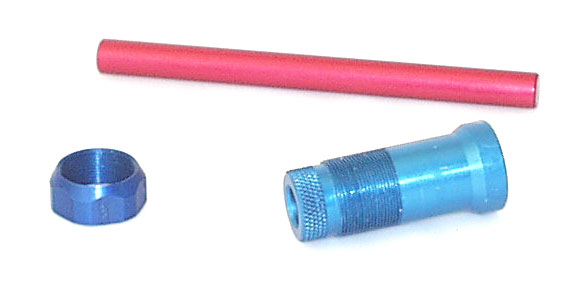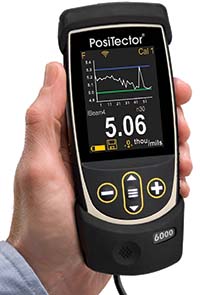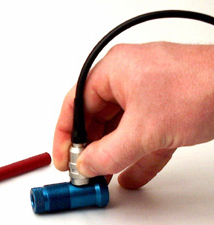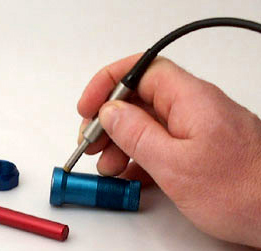DeFelsko manufactures a hand-held, non-destructive coating thickness gage that is ideal for measuring the thickness of anodizing on aluminum.

To efficiently control the thickness of anodizing and other thin coatings, an accurate non-destructive means of measurement is required.
A secondary challenge is the measurement of anodizing in small or hard-to-reach areas.

The PosiTector 6000 "N" series of eddy current gages are ideal for non-destructive measurement of nonconductive coatings on non-ferrous substrates. The PosiTector 6000 NAS probe is specifically designed for high resolution measurement of anodizing on aluminum. Though capable of measuring up to 625 μm (25 mils), the PosiTector 6000 NAS probe is most accurate and provides its highest resolution under 100 μm (4 mils) which is within the expected range of most anodizing applications.

When measuring coating thickness on small or hard-to-reach areas, the PosiTector 6000 N Microprobe series is an ideal measurement alternative. With probe tips of either 0°, 45° or 90° thickness readings can be taken in deep holes, on small ledges or on inside diameters. When a fixture or quick release adapter is used, N microprobes have identical specifications as the NAS probes.

For current pricing or to order these anodizing coating thickness instruments, please visit our Sales page.
Anodizing is an electrochemical conversion process in existence since the 1930s. Several metals are capable of being anodized including aluminum, magnesium, titanium, and tantalum. Anodized aluminum is used in many applications due to its low cost, aesthetic qualities, and ideal mechanical properties.
Unlike most protective coatings, anodizing permanently changes the outer structure of the metal. When aluminum is exposed to air it naturally develops a thin aluminum oxide film that seals the aluminum from further oxidation. The anodizing process makes the oxidized surface much thicker, up to several thousandths of an inch thick. The hardness of the anodized aluminum oxide coating rivals that of a diamond, enhancing the abrasion resistance of the aluminum. The added depth of the oxide layer improves the corrosion resistance of the aluminum, while making cleaning the surface easier. The porous nature of particular types of anodizing makes it possible to dye the aluminum a variety of colors, making it more attractive.
Anodizing typically ranges up to 5 mils thickness. The three most common variations of aluminum anodizing include chromic anodizing (type I), sulfuric anodizing (type II) and hard anodizing (type III).
The aluminum part is hung on stripped aluminum or titanium racks ensuring good electrical contact. Throughout the anodizing process, parts are affixed and the racks are suspended in a series of tanks.
An alternative to racking is bulk anodizing which is more ideal for anodizing small, irregularly shaped parts such as rivets, ferrules, and medical hubs. Instead of racks, parts are processed in perforated aluminum, plastic, or titanium baskets. Whether you need coil or batch production, anodizing provides one of the best aluminum finishing options in the industry.
Another alternative is coil anodizing. Coiled aluminum is pre-anodized to lower finishing costs, save production time, and reduce material handling. Advantages of pre-anodized aluminum can be applied to most products that are fabricated from sheet or coil stock. Products that are made from extrusions, castings, rod, bar, or plate are limited to piece anodizing processes such as racking or bulk.
Though most aluminum alloys will build aluminum oxide in an anodizing tank, they tend to anodize differently. Some alloys are more difficult to anodize while others anodize to slightly different shades of color. When anodized, various alloys provide different levels of workability (machining, grinding, polishing), environmental resistance properties, and dimensional stability.
Anodizing is a highly effective and desirable means of finishing aluminum. Some of the primary advantages of anodizing include:
The anodizing process parameters have a significant influence on the properties of the oxide formed. If low temperatures and acid concentrations are used, it yields a less porous and harder coating. Higher temperatures and acid content, along with longer immersion times produces softer, more porous coatings. Minor changes to the alloy itself or any of these parameters can significantly affect the coating.
Through various process controls and measurement techniques, Anodizers are able to monitor, control and correct the anodized coating application. One of the most critical quality controls for anodizing is thickness. Thickness of anodizing can be measured non-destructively using an eddy current coating thickness gage or by calculating weight per unit area. The simplicity of the eddy current method is not only more efficient than the calculation method, but also enables the inspector to verify that adequate anodizing occurs across all surfaces of the part.
Anodized products and components are used in thousands of commercial, industrial, and consumer applications:
AAC (Aluminum Anodizers Council)
AEC (Aluminum Extruders Council)
FGIA (Fenestration & Glazing Industry Alliance) — Formerly AAMA—Architectural Manufacturers Association
MIL-A-8625—Anodic Coatings for Aluminum and Aluminum Alloys
MIL-STD-171—Standard for Finishing and Treating Surfaces
ASTM B244-09—Standard Test Method for Measurement of Thickness of Anodic Coatings on Aluminum and of Other Nonconductive Coatings on Nonmagnetic Basis Metals with Eddy-Current Instruments
ASTM B487-85—Standard Test Method for Measurement of Metal and Oxide Coating Thickness by Microscopical Examination of a Cross Section
ASTM B137-95—Standard Test Method for Measurement of Coating Mass Per Unit Area on Anodically Coated Aluminum
ASTM B136-84—Standard Method for Measurement of Stain Resistance of Anodic Coatings on Aluminum
ASTM B457-67—Standard Test Method for Measurement of Impedance of Anodic Coatings on Aluminum
ASTM B580-79—Standard Specification for Anodic Oxide Coatings on Aluminum
ASTM B680-80—Standard Test Method for Seal Quality of Anodic Coatings on Aluminum by Acid Dissolution
ASTM B893-98—Specification for Hard-Coat Anodizing of Magnesium for Engineering Application
AMS2468—Hardcoating treatment of aluminum alloys
AMS2469—Hardcoating treatment of aluminum and aluminum alloys
AMS2471—Anodic Treatment of Aluminum Alloys Sulfuric Acid Process, Process-Undyed
AMS2472—Anodic Treatment of Aluminum Alloys Sulfuric Acid Process, Process-Dyed
AMS-A-8625—Anodic Coatings for Aluminum and Aluminum Alloys (copy of MIL-A-8625)
ISO 7599—Anodizing of aluminium and its alloys; General specifications for anodic oxide coatings on aluminium
ISO 8078—Anodic treatment of aluminum alloys – Sulfuric acid process, undyed coating
ISO 8079—Anodic treatment of aluminum alloys – Sulfuric acid process, dyed coating
ISO 10074—Specification for hard anodic oxidation coatings on aluminum and its alloys
BS/DIN EN 2101—Specification for chromic acid anodizing of aluminium and wrought aluminium alloys
BS/DIN 2284—Specification for sulfuric acid anodizing of aluminium and wrought aluminium alloys
BS/DIN 2536—Hard anodizing of aluminium alloys
BS/DIN 2808—Anodizing of titanium and titanium alloys
DIN EN ISO 7599—Anodizing aluminum and aluminum alloys - Method for specifying decorative and protective anodically produced oxide layers on aluminum